Active Terahertz Modulator and Slow Light Metamaterial Devices with Hybrid Graphene–Superconductor Photonic Integrated Circuits
Abstract
:1. Introduction
2. Design of the Hybrid Photonic Integrated Circuits
3. Results and Discussion
3.1. Superconducting THz Photonic Circuits without Graphene Patches
3.2. Integration of Graphene with Superconducting THz Photonic Circuits
3.3. Modulation of THz Waves in Hybrid Graphene Superconducting Photonic Circuits with Temperature
3.4. Modulation of THz Waves in Hybrid Superconducting Photonic Circuits with Voltage
3.5. The Equivalent RLC Circuit Model of Hybrid Graphene Superconducting THz Photonic Circuits
3.6. Active Control of Slow Light Effect in Hybrid Superconducting THz Photonic Circuits
4. Conclusions
Author Contributions
Funding
Data Availability Statement
Conflicts of Interest
Appendix A. Equivalent RLC Model
Appendix B. Group Delay Characteristics of Coupled SRR with Different Materials
| @ 0 mS | Device Number | Max Group Delay (ps) | EIT Bandwidth (THz) | Max Delay-EIT BandWidth Product (DBP) |
|---|---|---|---|---|
| Nb (4.5 K)/Au | 1 | 0.548 | 0.107 | 0.05863 |
| Nb (10 K)/Au | 2 | 0.444 | 0.106 | 0.04706 |
| Au/Nb (4.5 K) | 3 | 1.287 | 0.134 | 0.17245 |
| Au/Nb (10 K) | 4 | 0.565 | 0.125 | 0.07062 |
| Au/Au | 5 | 0.396 | 0.105 | 0.04158 |
| Nb (4.5 K)/Nb (4.5 K) | 6 | 2.87 | 0.161 | 0.46207 |
| Nb (10 K)/Nb (10 K) | 7 | 0.874 | 0.132 | 0.1118 |
| @ 0.9 mS | Device Number | Max Group Delay (ps) | EIT Bandwidth (THz) | Max Delay-EIT BandWidth Product (DBP) |
|---|---|---|---|---|
| Nb (4.5 K)/Au * | 1 | ------ | ------ | -------- |
| Nb (10 K)/Au * | 2 | ------ | ------ | -------- |
| Au/Nb (4.5 K) | 3 | 0.410 | 0.094 | 0.03854 |
| Au/Nb (10 K) | 4 | 0.210 | 0.086 | 0.01806 |
| Au/Au | 5 | 0.114 | 0.016 | 0.00182 |
| Nb (4.5 K)/Nb (4.5 K) | 6 | 0.555 | 0.099 | 0.05494 |
| Nb (10 K)/Nb (10 K) | 7 | 0.242 | 0.079 | 0.01911 |
References
- Singh, R.; Zheludev, N. Superconductor photonics. Nat. Photonics 2014, 8, 679–680. [Google Scholar] [CrossRef]
- Braginski, A.I. Superconductor Electronics: Status and Outlook. J. Supercond. Nov. Magn. 2018, 32, 23–44. [Google Scholar] [CrossRef] [Green Version]
- Keller, J.; Scalari, G.; Appugliese, F.; Mavrona, E.; Rajabali, S.; Süess, M.J.; Beck, M.; Faist, J.J.; Su, M.J.; Beck, M. High Tc Superconducting THz Metamaterial for Ultrastrong Coupling in a Magnetic Field. ACS Photonics 2018, 5, 3977–3983. [Google Scholar] [CrossRef]
- Duan, S.; Wu, J.; Shen, Z.; Guan, Y.; Jia, X. Tunable and high quality factor Fano and toroidal dipole resonances in terahertz superconducting metamaterials Tunable and high quality factor Fano and toroidal dipole resonances in terahertz superconducting metamaterials. Mater. Res. Express 2020, 7, 046001. [Google Scholar] [CrossRef]
- Delfanazari, K.; Muskens, O.L. Light-matter interactions in chip-integrated niobium nano- circuit arrays at optical fibre communication frequencies. arXiv 2021, arXiv:2106.11961. [Google Scholar]
- Delfanazari, K.; Muskens, O.L. On-chip visible light communication-band metasurface modulators with niobium plasmonic nano-antenna arrays. arXiv 2021, arXiv:2107.09939. [Google Scholar]
- Liu, M.; Yin, X.; Ulin-Avila, E.; Geng, B.; Zentgraf, T.; Ju, L.; Wang, F.; Zhang, X. A graphene-based broadband optical modulator. Nature 2011, 474, 64–67. [Google Scholar] [CrossRef]
- Delfanazari, K.; Puddy, R.K.; Ma, P.; Yi, T.; Cao, M.; Gul, Y.; Farrer, I.; Ritchie, D.A.; Joyce, H.J.; Kelly, M.J.; et al. On-Chip Andreev Devices: Hard Superconducting Gap and Quantum Transport in Ballistic Nb–In0.75Ga0.25As-Quantum-Well–Nb Josephson Junctions. Adv. Mater. 2017, 29, 1701836. [Google Scholar] [CrossRef] [Green Version]
- Delfanazari, K.; Puddy, R.K.; Ma, P.; Yi, T.; Cao, M.; Richardson, C.; Farrer, I.; Ritchie, D.A.; Joyce, H.J.; Kelly, M.J.; et al. On-chip Hybrid Superconducting-Semiconducting Quantum Circuit. IEEE Trans. Appl. Supercond. 2018, 28, 1100304. [Google Scholar] [CrossRef]
- Ben Shalom, M.; Zhu, M.J.; Fal’ko, V.I.; Mishchenko, A.; Kretinin, A.V.; Novoselov, K.S.; Woods, C.R.; Watanabe, K.; Taniguchi, T.; Geim, A.K.; et al. Quantum oscillations of the critical current and high-field superconducting proximity in ballistic graphene. Nat. Phys. 2016, 12, 318–322. [Google Scholar] [CrossRef] [Green Version]
- Bretheau, L.; Wang, J.I.J.; Pisoni, R.; Watanabe, K.; Taniguchi, T.; Jarillo-Herrero, P. Tunnelling spectroscopy of Andreev states in graphene. Nat. Phys. 2017, 13, 756–760. [Google Scholar] [CrossRef] [Green Version]
- Smith, D.R.; Pendry, J.B.; Wiltshire, M.C.K. Metamaterials and negative refractive index. Science 2004, 305, 788–792. [Google Scholar] [CrossRef] [PubMed] [Green Version]
- Kurter, C.; Tassin, P.; Zhang, L.; Koschny, T.; Zhuravel, A.P.; Ustinov, A.V.; Anlage, S.M.; Soukoulis, C.M. Classical analogue of electromagnetically induced transparency with a metal-superconductor hybrid metamaterial. Phys. Rev. Lett. 2011, 107, 043901. [Google Scholar] [CrossRef] [PubMed] [Green Version]
- Li, Z.; Ma, Y.; Huang, R.; Singh, R.; Gu, J.; Tian, Z.; Han, J.; Zhang, W. Manipulating the plasmon-induced transparency in terahertz metamaterials. Opt. Express 2011, 19, 8912. [Google Scholar] [CrossRef] [PubMed] [Green Version]
- Boiler, K.-J.; Imamoglu, A.; Harris, S.E. Observation of electromagnetically induced transparency. Phys. Rev. Lett. 1991, 66, 2593–2596. [Google Scholar] [CrossRef] [Green Version]
- Nakanishi, T.; Otani, T.; Tamayama, Y.; Kitano, M. Storage of electromagnetic waves in a metamaterial that mimics electromagnetically induced transparency. Phys. Rev. B 2013, 87, 161110. [Google Scholar] [CrossRef] [Green Version]
- Gu, J.; Singh, R.; Liu, X.; Zhang, X.; Ma, Y.; Zhang, S.; Maier, S.A.; Tian, Z.; Azad, A.K.; Chen, H.T.; et al. Active control of electromagnetically induced transparency analogue in terahertz metamaterials. Nat. Commun. 2012, 3, 1151. [Google Scholar] [CrossRef] [Green Version]
- Kindness, S.J.; Jessop, D.S.; Wei, B.; Wallis, R.; Kamboj, V.S.; Xiao, L.; Ren, Y.; Braeuninger-Weimer, P.; Aria, A.I.; Hofmann, S.; et al. External amplitude and frequency modulation of a terahertz quantum cascade laser using metamaterial/graphene devices. Sci. Rep. 2017, 7, 7657. [Google Scholar] [CrossRef]
- Wang, F.; Pistore, V.; Riesch, M.; Nong, H.; Vigneron, P.B.; Colombelli, R.; Parillaud, O.; Mangeney, J.; Tignon, J.; Jirauschek, C.; et al. Ultrafast response of harmonic modelocked THz lasers. Light Sci. Appl. 2020, 9, 51. [Google Scholar] [CrossRef] [Green Version]
- Kindness, S.J.; Almond, N.W.; Michailow, W.; Wei, B.; Delfanazari, K.; Braeuninger-Weimer, P.; Hofmann, S.; Beere, H.E.; Ritchie, D.A.; Degl’Innocenti, R. A Terahertz Chiral Metamaterial Modulator. Adv. Opt. Mater. 2020, 8, 2000581. [Google Scholar] [CrossRef]
- Delfanazari, K.; Klemm, R.A.; Joyce, H.J.; Ritchie, D.A.; Kadowaki, K. Integrated, Portable, Tunable, and Coherent Terahertz Sources and Sensitive Detectors Based on Layered Superconductors. Proc. IEEE 2020, 108, 721–734. [Google Scholar] [CrossRef]
- Welp, U.; Kadowaki, K.; Kleiner, R. Superconducting emitters of THz radiation. Nat. Photonics 2013, 7, 702–710. [Google Scholar] [CrossRef]
- Delfanazari, K.; Asai, H.; Tsujimoto, M.; Kashiwagi, T.; Kitamura, T.; Ishida, K.; Watanabe, C.; Sekimoto, S.; Yamamoto, T.; Minami, H.; et al. Terahertz oscillating devices based upon the intrinsic josephson junctions in a high temperature superconductor. J. Infrared Millim. Terahertz Waves 2014, 35, 131–146. [Google Scholar] [CrossRef]
- Delfanazari, K.; Asai, H.; Tsujimoto, M.; Kashiwagi, T.; Kitamura, T.; Yamamoto, T.; Sawamura, M.; Ishida, K.; Tachiki, M.; Klemm, R.A.; et al. Study of coherent and continuous terahertz wave emission in equilateral triangular mesas of superconducting Bi2Sr2CaCu 2O8+δ intrinsic Josephson junctions. Phys. C Supercond. Appl. 2013, 491, 16–19. [Google Scholar] [CrossRef]
- Ozyuzer, L.; Koshelev, A.E.; Kurter, C.; Gopalsami, N.; Li, Q.; Tachiki, M.; Kadowaki, K.; Yamamoto, T.; Minami, H.; Yamaguchi, H.; et al. Emission of coherent THz radiation from superconductors. Science 2007, 318, 1291–1293. [Google Scholar] [CrossRef] [Green Version]
- Delfanazari, K.; Asai, H.; Tsujimoto, M.; Kashiwagi, T.; Kitamura, T.; Yamamoto, T.; Wilson, W.; Klemm, R.A.; Hattori, T.; Kadowaki, K. Effect of bias electrode position on terahertz radiation from pentagonal mesas of superconducting Bi2Sr2CaCu2O8+δ. IEEE Trans. Terahertz Sci. Technol. 2015, 5, 505–511. [Google Scholar] [CrossRef] [Green Version]
- Kadowaki, K.; Tsujimoto, M.; Delfanazari, K.; Kitamura, T.; Sawamura, M.; Asai, H.; Yamamoto, T.; Ishida, K.; Watanabe, C.; Sekimoto, S.; et al. Quantum terahertz electronics (QTE) using coherent radiation from high temperature superconducting Bi2Sr2CaCu2O 8+δ intrinsic Josephson junctions. Phys. C Supercond. Appl. 2013, 491, 2–6. [Google Scholar] [CrossRef]
- Delfanazari, K.; Asai, H.; Tsujimoto, M.; Kashiwagi, T.; Kitamura, T.; Yamamoto, T.; Sawamura, M.; Ishida, K.; Watanabe, C.; Sekimoto, S.; et al. Tunable terahertz emission from the intrinsic Josephson junctions in acute isosceles triangular Bi2Sr2CaCu2O8+δ mesas. Opt. Express 2013, 21, 2171. [Google Scholar] [CrossRef]
- Tsujimoto, M.; Yamamoto, T.; Delfanazari, K.; Nakayama, R.; Kitamura, T.; Sawamura, M.; Kashiwagi, T.; Minami, H.; Tachiki, M.; Kadowaki, K.; et al. Broadly tunable subterahertz emission from Internal Branches of the current-Voltage characteristics of superconducting Bi2Sr2CaCu2O8+δ single crystals. Phys. Rev. Lett. 2012, 108, 107006. [Google Scholar] [CrossRef] [Green Version]
- Xiong, Y.; Kashiwagi, T.; Klemm, R.A.; Kadowaki, K.; Delfanazari, K. Engineering the Cavity modes and Polarization in Integrated Superconducting Coherent Terahertz Emitters. In Proceedings of the 2020 45th International Conference on Infrared, Millimeter, and Terahertz Waves (IRMMW-THz), Buffalo, NY, USA,, 8–13 November 2020; pp. 866–867. [Google Scholar] [CrossRef]
- Kalhor, S.; Ghanaatshoar, M.; Kashiwagi, T.; Kadowaki, K.; Kelly, M.J.; Delfanazari, K. Thermal Tuning of High-Tc Superconducting Bi2Sr2CaCu2O8 Terahertz Metamaterial. IEEE Photonics J. 2017, 9, 1–8. [Google Scholar] [CrossRef] [Green Version]
- Kalhor, S.; Ghanaatshoar, M.; Delfanazari, K. On-chip Superconducting THz Metamaterial Bandpass Filter. In Proceedings of the 2020 45th International Conference on Infrared, Millimeter, and Terahertz Waves (IRMMW-THz), Buffalo, NY, USA, 8–13 November 2020; pp. 1–2. [Google Scholar] [CrossRef]
- Kalhor, S.; Ghanaatshoar, M.; Delfanazari, K. Guiding of terahertz photons in superconducting nano-circuits. In Proceedings of the 2020 International Conference on UK-China Emerging Technologies (UCET), Glasgow, UK, 20–21 August 2020; pp. 27–29. [Google Scholar] [CrossRef]
- Zhang, C.; Wu, J.; Jin, B.; Jia, X.; Kang, L.; Xu, W.; Wang, H.; Chen, J.; Tonouchi, M.; Wu, P. Tunable electromagnetically induced transparency from a superconducting terahertz metamaterial. Appl. Phys. Lett. 2017, 110, 241105. [Google Scholar] [CrossRef]
- Srivastava, Y.K.; Manjappa, M.; Cong, L.; Krishnamoorthy, H.N.S.; Savinov, V.; Pitchappa, P.; Singh, R. A Superconducting Dual-Channel Photonic Switch. Adv. Mater. 2018, 30, 1801257. [Google Scholar] [CrossRef] [Green Version]
- Cao, W.; Singh, R.; Zhang, C.; Han, J.; Tonouchi, M.; Zhang, W. Plasmon-induced transparency in metamaterials: Active near field coupling between bright superconducting and dark metallic mode resonators. Appl. Phys. Lett. 2013, 103, 101106. [Google Scholar] [CrossRef] [Green Version]
- Jin, B.B.; Wu, J.B.; Zhang, C.H.; Jia, X.Q.; Jia, T.; Kang, L.; Chen, J.; Wu, P.H.; Science, S. Enhanced slow light in superconducting electromagnetically induced transparency metamaterials. Supercond. Sci. Technol. 2013, 26, 74004. [Google Scholar] [CrossRef]
- Zhang, Y.; Li, C.; Tu, X. Tuning electromagnetically induced transparency of superconducting metamaterial analyzed with equivalent circuit approach. Prog. Electromagn. Res. M 2020, 91, 29–37. [Google Scholar] [CrossRef]
- Limaj, O.; Giorgianni, F.; Di Gaspare, A.; Giliberti, V.; De Marzi, G.; Roy, P.; Ortolani, M.; Xi, X.; Cunnane, D.; Lupi, S. Superconductivity-Induced Transparency in Terahertz Metamaterials. ACS Photonics 2014, 1, 570–575. [Google Scholar] [CrossRef]
- Li, C.; Wu, J.; Jiang, S.; Su, R.; Zhang, C.; Jiang, C.; Zhou, G.; Jin, B.; Kang, L.; Xu, W.; et al. Electrical dynamic modulation of THz radiation based on superconducting metamaterials. Appl. Phys. Lett. 2017, 111, 092601. [Google Scholar] [CrossRef]
- Jung, H.; Jo, H.; Lee, W.; Kim, B.; Choi, H.; Kang, M.S.; Lee, H. Electrical Control of Electromagnetically Induced Transparency by Terahertz Metamaterial Funneling. Adv. Opt. Mater. 2019, 7, 1801205. [Google Scholar] [CrossRef]
- Kim, T.T.; Kim, H.D.; Zhao, R.; Oh, S.S.; Ha, T.; Chung, D.S.; Lee, Y.H.; Min, B.; Zhang, S. Electrically Tunable Slow Light Using Graphene Metamaterials. ACS Photonics 2018, 5, 1800–1807. [Google Scholar] [CrossRef] [Green Version]
- Kindness, S.J.; Almond, N.W.; Michailow, W.; Wei, B.; Jakob, L.A.; Delfanazari, K.; Braeuninger-Weimer, P.; Hofmann, S.; Beere, H.E.; Ritchie, D.A.; et al. Graphene-Integrated Metamaterial Device for All-Electrical Polarization Control of Terahertz Quantum Cascade Lasers. ACS Photonics 2019, 6, 1547–1555. [Google Scholar] [CrossRef] [Green Version]
- Degl’Innocenti, R.; Kindness, S.J.; Beere, H.E.; Ritchie, D.A. All-integrated terahertz modulators. Nanophotonics 2018, 7, 127–144. [Google Scholar] [CrossRef]
- Maier, S.A. Plasmonics Fundamentals and Applications; Springer Science & Business Media: Berlin/Heidelberg, Germany, 2007; ISBN 9780387331508. [Google Scholar]
- Kindness, S.J.; Almond, N.W.; Wei, B.; Wallis, R.; Michailow, W.; Kamboj, V.S.; Braeuninger-Weimer, P.; Hofmann, S.; Beere, H.E.; Ritchie, D.A.; et al. Active Control of Electromagnetically Induced Transparency in a Terahertz Metamaterial Array with Graphene for Continuous Resonance Frequency Tuning. Adv. Opt. Mater. 2018, 6, 1800570. [Google Scholar] [CrossRef] [Green Version]
- Wang, D.; Zhao, W.; Gu, X.; Chen, W.; Yin, W.; An, A. Wideband Modeling of Graphene-Based Structures at Different Temperatures Using Hybrid FDTD Method. IEEE Trans. Nanotechnol. 2015, 14, 250–258. [Google Scholar] [CrossRef]
- Gusynin, V.P.; And, S.G.S.; Carbotte, J.P. On the universal ac optical background in graphene. New J. Phys. 2009, 11, 095013. [Google Scholar] [CrossRef]
- Anlage, S.M. The physics and applications of superconducting metamaterials. J. Opt. 2011, 13, 024001. [Google Scholar] [CrossRef] [Green Version]
- Anlage, S.M. Microwave Superconductivity. IEEE J. Microw. 2021, 1, 389–402. [Google Scholar] [CrossRef]
- Ordal, M.A.; Long, L.L.; Bell, R.J.; Bell, S.E.; Bell, R.R.; Alexander, R.W.; Ward, C.A. Optical properties of the metals Al, Co, Cu, Au, Fe, Pb, Ni, Pd, Pt, Ag, Ti, and W in the infrared and far infrared. Appl. Opt. 1983, 22, 1099. [Google Scholar] [CrossRef]
- Cui, T.J.; Smith, D.R.; Liu, R. Metamaterials: Theory, Design and Applications; Springer: Heidelberg, Germany, 2010; ISBN 9781441905727. [Google Scholar]
- Tassin, P.; Zhang, L.; Koschny, T.; Economou, E.N.; Soukoulis, C.M. Low-loss metamaterials based on classical electromagnetically induced transparency. Phys. Rev. Lett. 2009, 102, 6–9. [Google Scholar] [CrossRef] [Green Version]
- Sensale-Rodriguez, B.; Yan, R.; Kelly, M.M.; Fang, T.; Tahy, K.; Hwang, W.S.; Jena, D.; Liu, L.; Xing, H.G. Broadband graphene terahertz modulators enabled by intraband transitions. Nat. Commun. 2012, 3, 780–787. [Google Scholar] [CrossRef]
- Srivastava, Y.K.; Manjappa, M.; Krishnamoorthy, H.N.S.; Singh, R. Accessing the High-Q Dark Plasmonic Fano Resonances in Superconductor Metasurfaces. Adv. Opt. Mater. 2016, 4, 1875–1881. [Google Scholar] [CrossRef]
- Srivastava, Y.K.; Manjappa, M.; Cong, L.; Cao, W.; Al-Naib, I.; Zhang, W.; Singh, R. Ultrahigh-Q Fano Resonances in Terahertz Metasurfaces: Strong Influence of Metallic Conductivity at Extremely Low Asymmetry. Adv. Opt. Mater. 2016, 4, 457–463. [Google Scholar] [CrossRef]
- Caloz, C.; Itoh, T. Electromagnetic Metamaterials: Transmission Line Theory and Microwave the Engineering Approach; John Wiley & Sons: Hoboken, NJ, USA, 2005; ISBN 9780471669852. [Google Scholar]
- Capolino, F. Theory and Phenomena of Metamaterials; CRC Press: Boca Raton, FL, USA, 2017; Volume 8, ISBN 978-1-4200-5425-5. [Google Scholar]
- Amin, M.; Farhat, M.; Bag, H. A dynamically reconfigurable Fano metamaterial through graphene tuning for switching and sensing applications. Sci. Rep. 2013, 3, 2105. [Google Scholar] [CrossRef] [Green Version]
- Wu, J.; Jin, B.; Wan, J.; Liang, L.; Zhang, Y.; Jia, T.; Cao, C.; Kang, L.; Xu, W.; Chen, J.; et al. Superconducting terahertz metamaterials mimicking electromagnetically induced transparency. Appl. Phys. Lett. 2011, 99, 161113. [Google Scholar] [CrossRef]
- Liu, C.; Liu, P.; Yang, C.; Lin, Y.; Liu, H. Analogue of dual-controlled electromagnetically induced transparency based on a graphene metamaterial. Carbon N. Y. 2019, 142, 354–362. [Google Scholar] [CrossRef]
- Liu, C.; Zha, S.; Liu, P.; Yang, C.; Zhou, Q. Electrical Manipulation of Electromagnetically Induced Transparency for Slow Light Purpose Based on Metal-Graphene Hybrid Metamaterial. Appl. Sci. 2018, 8, 2672. [Google Scholar] [CrossRef] [Green Version]

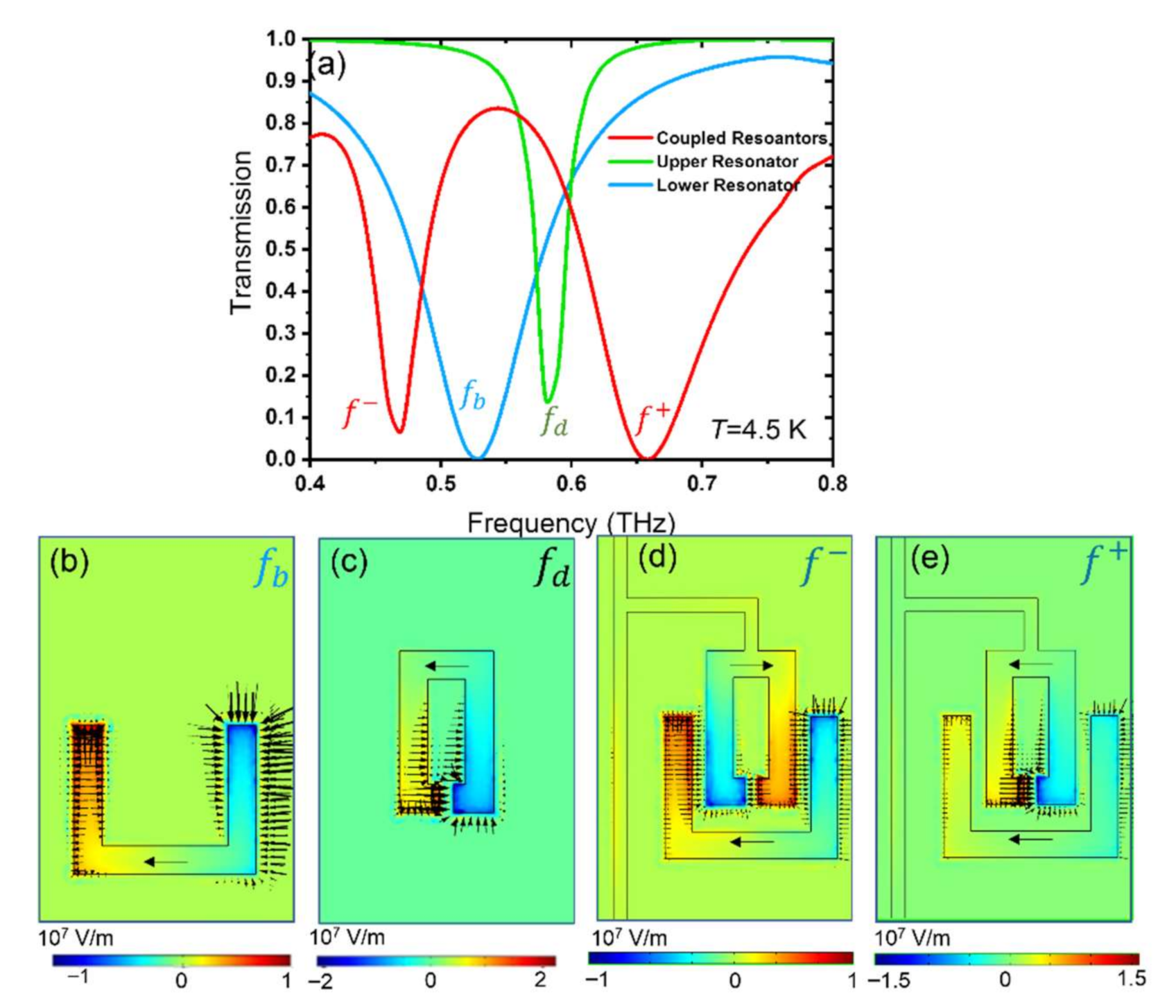
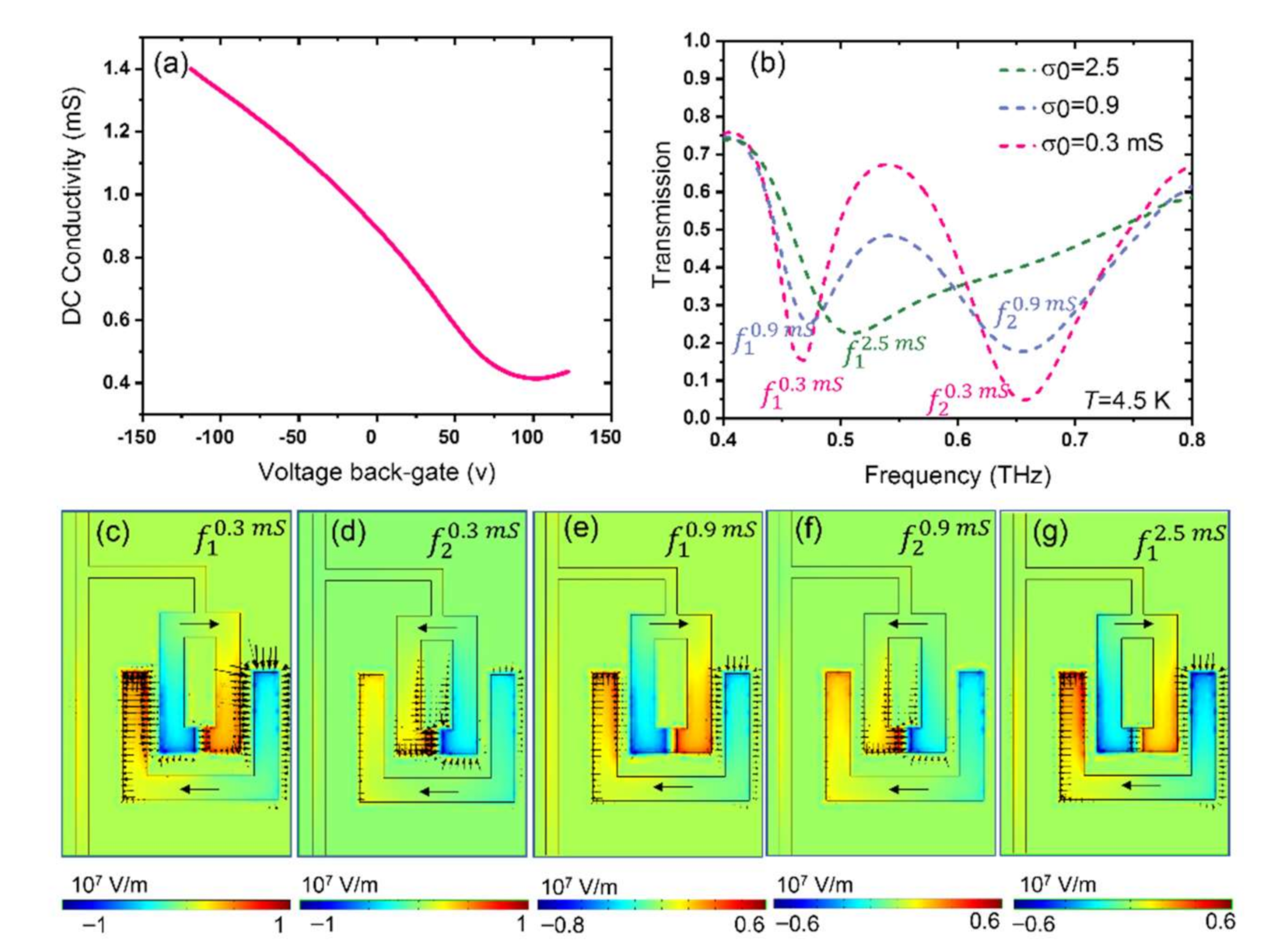
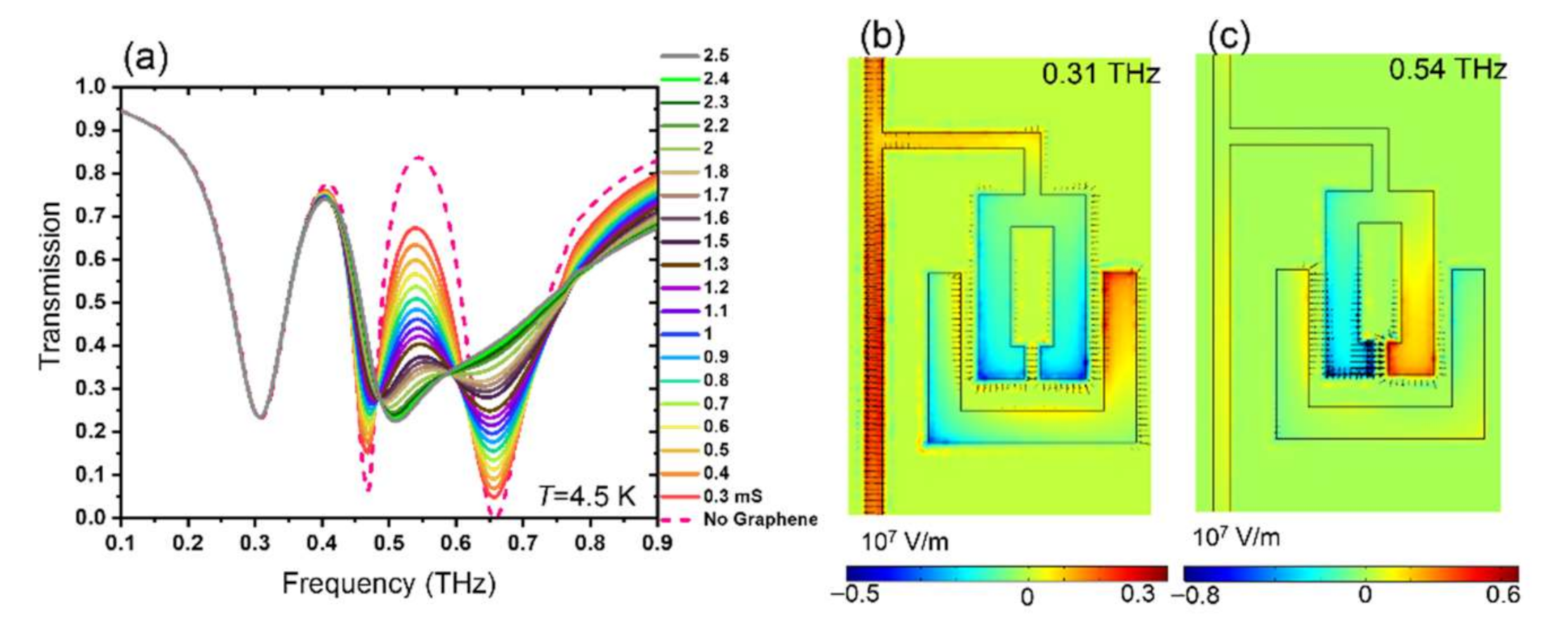
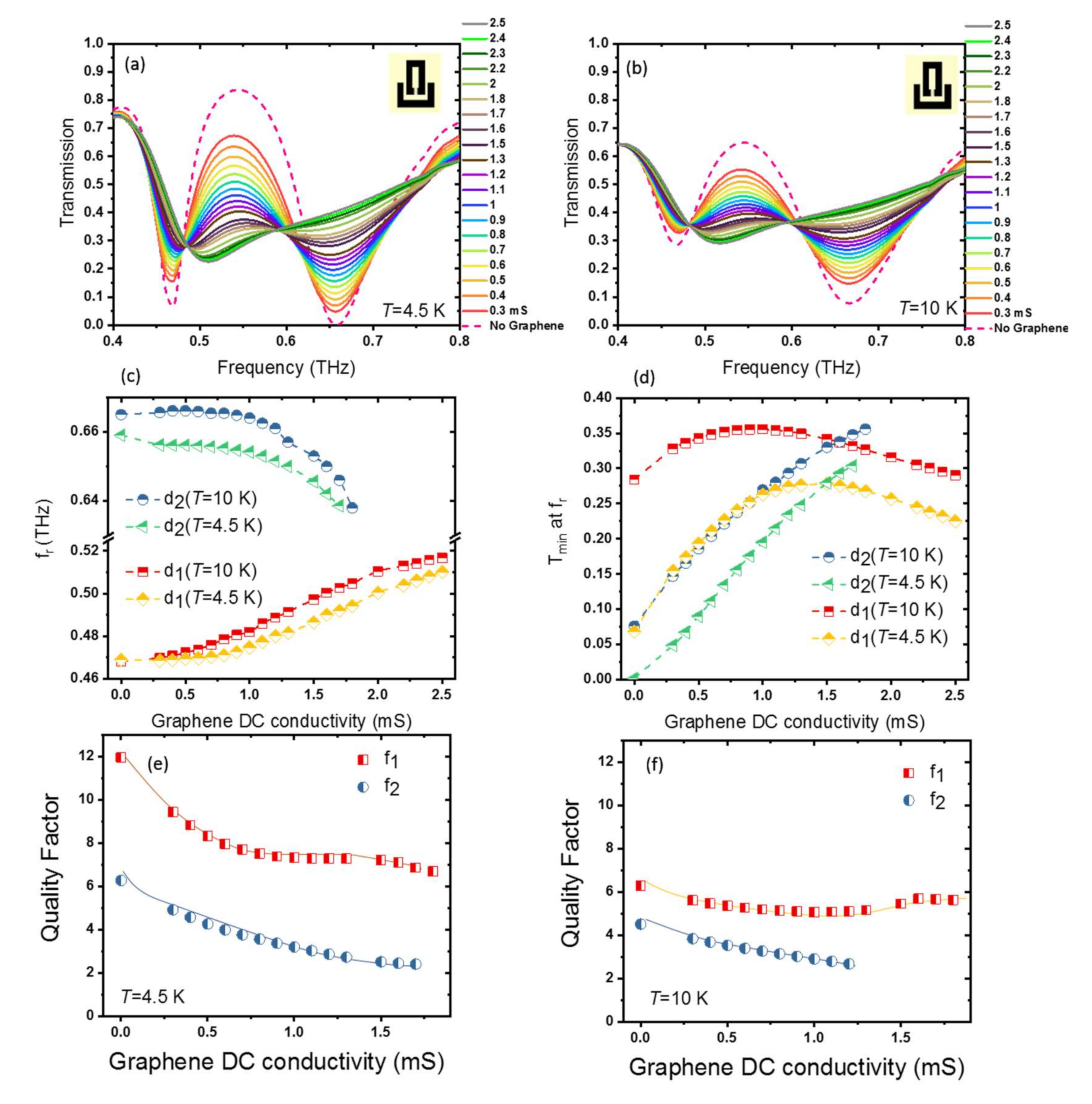

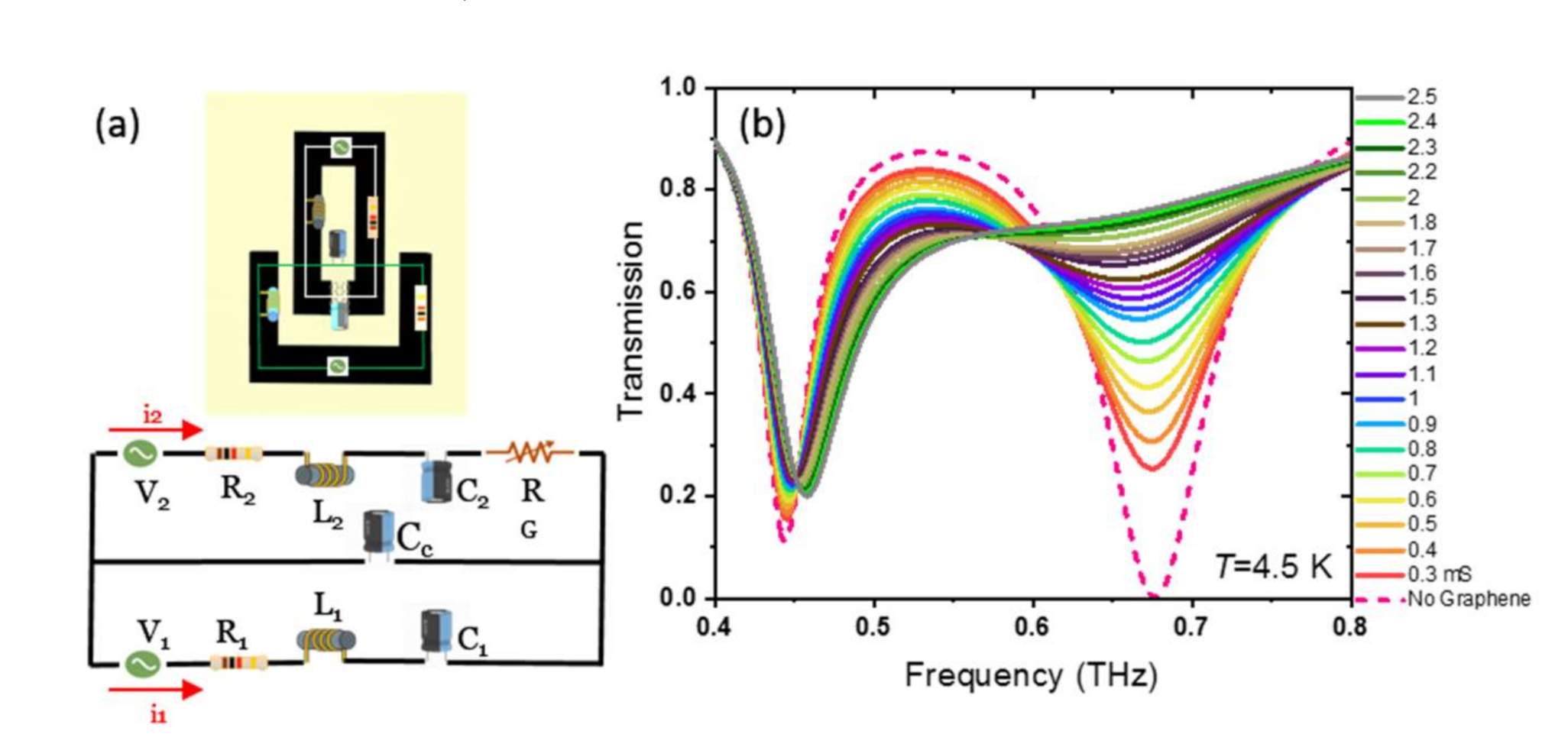
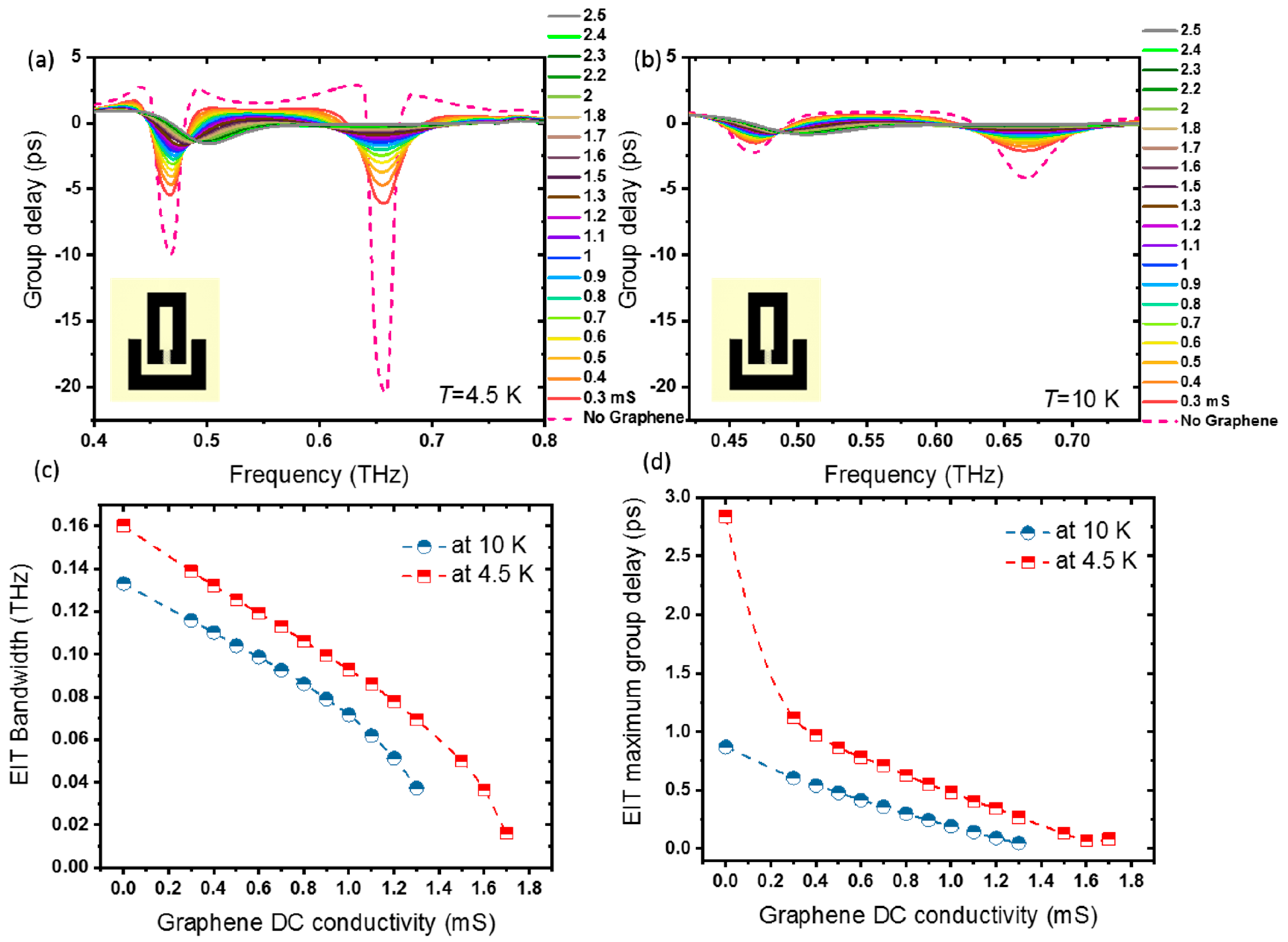
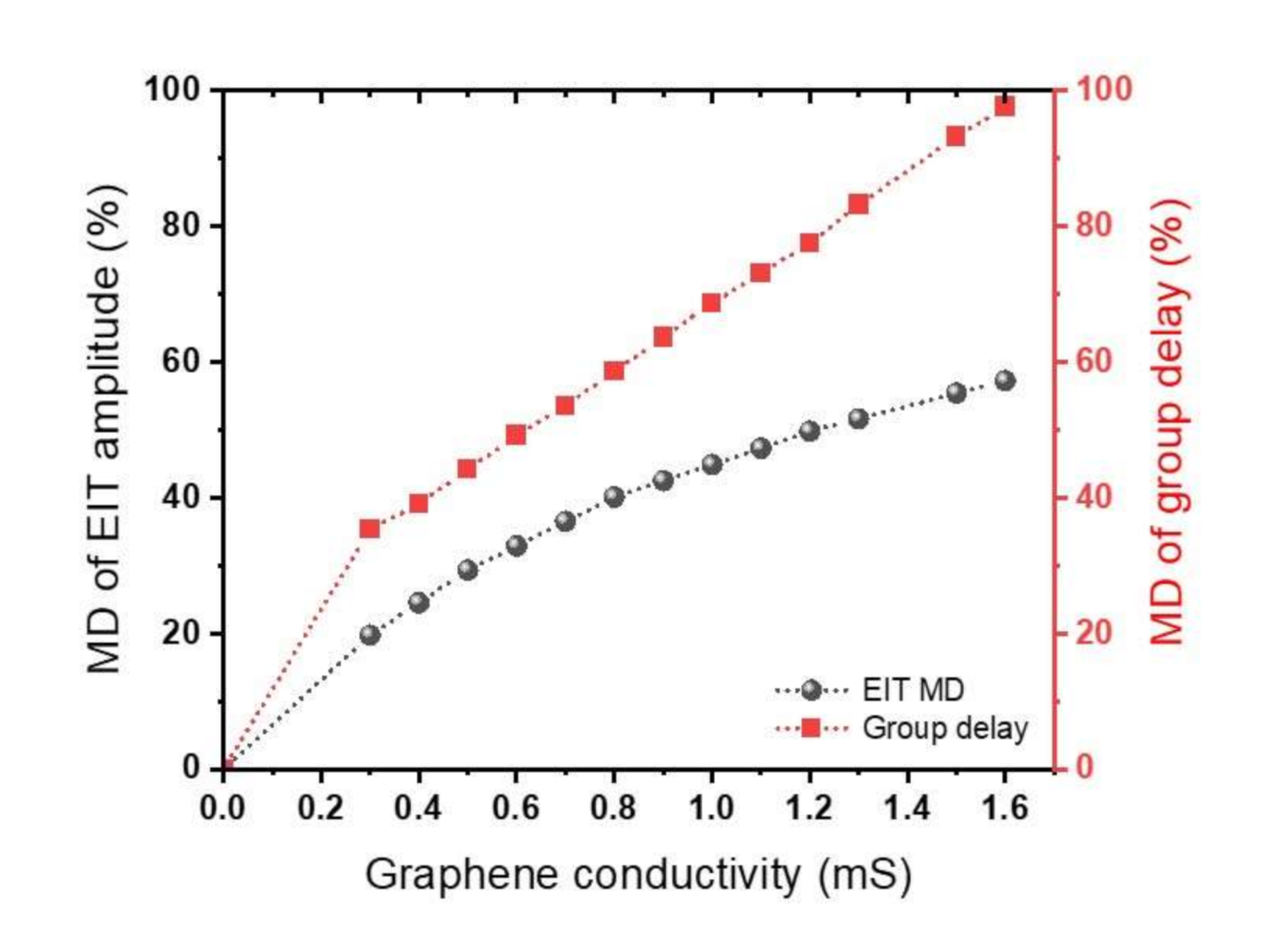
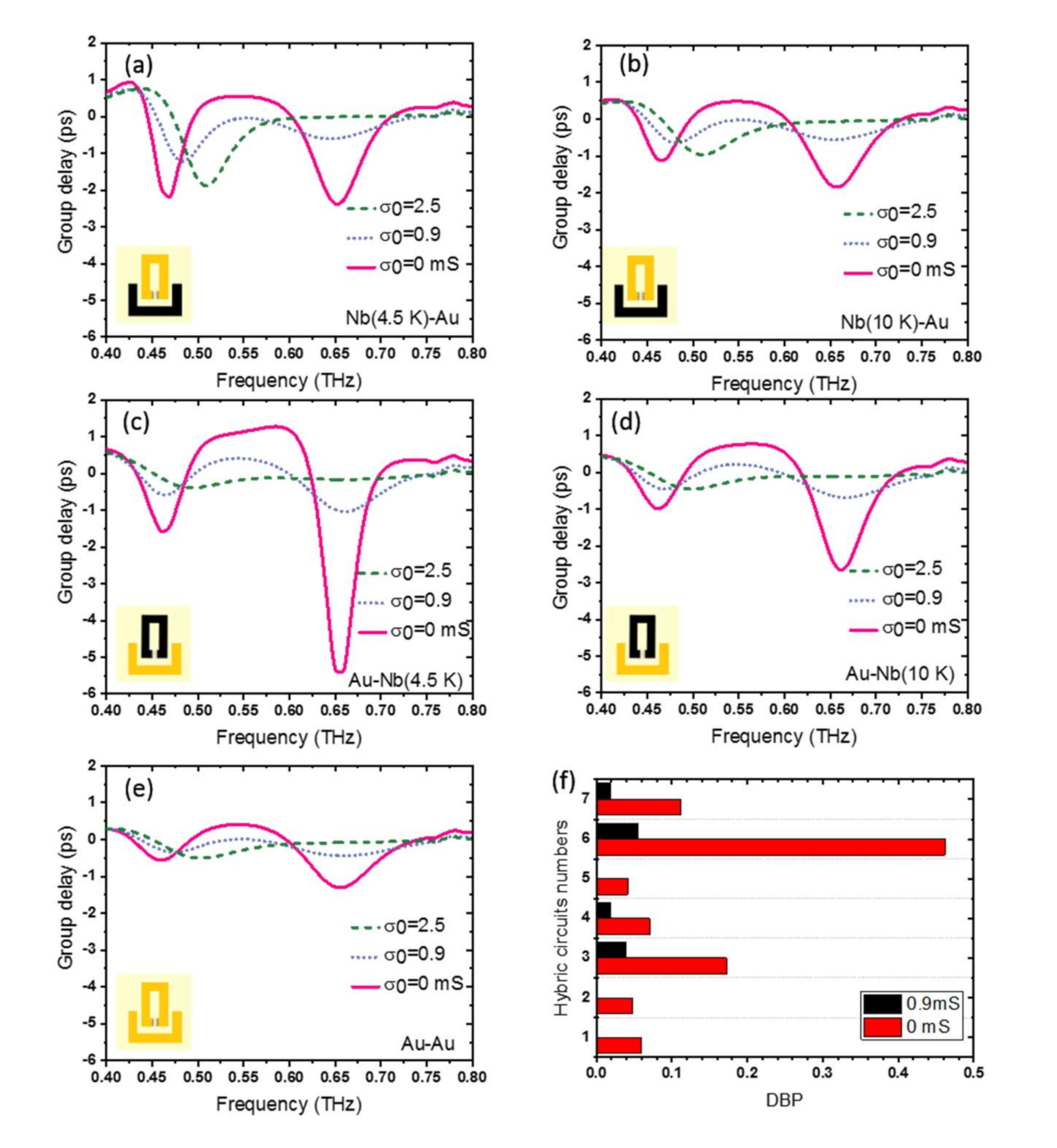
| (Ω) | (pH) | (fF) | (Ω) | (pH) | (fF) |
|---|---|---|---|---|---|
| 4.2712 | 0.2156 | 7.2453 | 6.9322 | 0.1276 | 5.9021 |
Publisher’s Note: MDPI stays neutral with regard to jurisdictional claims in published maps and institutional affiliations. |
© 2021 by the authors. Licensee MDPI, Basel, Switzerland. This article is an open access article distributed under the terms and conditions of the Creative Commons Attribution (CC BY) license (https://creativecommons.org/licenses/by/4.0/).
Share and Cite
Kalhor, S.; Kindness, S.J.; Wallis, R.; Beere, H.E.; Ghanaatshoar, M.; Degl’Innocenti, R.; Kelly, M.J.; Hofmann, S.; Joyce, H.J.; Ritchie, D.A.; et al. Active Terahertz Modulator and Slow Light Metamaterial Devices with Hybrid Graphene–Superconductor Photonic Integrated Circuits. Nanomaterials 2021, 11, 2999. https://doi.org/10.3390/nano11112999
Kalhor S, Kindness SJ, Wallis R, Beere HE, Ghanaatshoar M, Degl’Innocenti R, Kelly MJ, Hofmann S, Joyce HJ, Ritchie DA, et al. Active Terahertz Modulator and Slow Light Metamaterial Devices with Hybrid Graphene–Superconductor Photonic Integrated Circuits. Nanomaterials. 2021; 11(11):2999. https://doi.org/10.3390/nano11112999
Chicago/Turabian StyleKalhor, Samane, Stephen J. Kindness, Robert Wallis, Harvey E. Beere, Majid Ghanaatshoar, Riccardo Degl’Innocenti, Michael J. Kelly, Stephan Hofmann, Hannah J. Joyce, David A. Ritchie, and et al. 2021. "Active Terahertz Modulator and Slow Light Metamaterial Devices with Hybrid Graphene–Superconductor Photonic Integrated Circuits" Nanomaterials 11, no. 11: 2999. https://doi.org/10.3390/nano11112999
APA StyleKalhor, S., Kindness, S. J., Wallis, R., Beere, H. E., Ghanaatshoar, M., Degl’Innocenti, R., Kelly, M. J., Hofmann, S., Joyce, H. J., Ritchie, D. A., & Delfanazari, K. (2021). Active Terahertz Modulator and Slow Light Metamaterial Devices with Hybrid Graphene–Superconductor Photonic Integrated Circuits. Nanomaterials, 11(11), 2999. https://doi.org/10.3390/nano11112999







